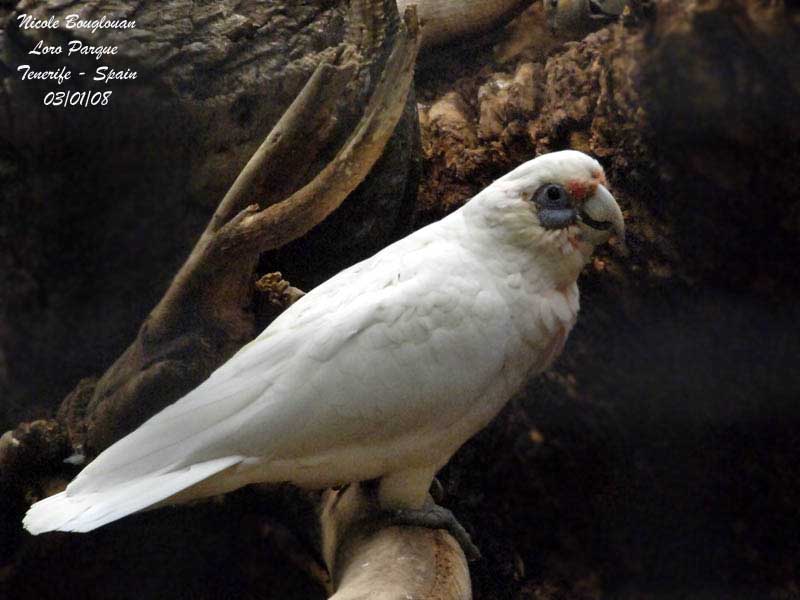
Western Corella
Cacatua pastinator
Psittaciforme Order – Cacatuidae Family
BIOMETRICS:
Length: 37-40 cm
Weight: Male: 700g – Female: 600 g.
LONGEVITY : 50 years at least
DESCRIPTION:
Western Corella is endemic to Australia.

Western Corella adult male has white plumage overall on upperparts and head.
On the underparts, under wing and undertail are washed pale yellow.
White head and neck show salmon-red concealed bases of feathers, which give varying red areas on face and forehead.
Western Corella has a white medium-sized crest. Hooked bill is slender and horn-coloured, with long upper mandible. Eyes are brown, with broad, bare blue skin as eye-ring, more extensive beneath the eye. Lores are red. Legs and feet are grey.
Female is similar but slightly smaller than male.
Juvenile resembles adults, but it has shorter bill.
We can find two subspecies:
Cacatua pastinator pastinator has orange-red lores and darker brown eyes. It lives in extreme south-western Australia, in a very restricted area.
Cacatua pastinator derbyi is smaller. It lives in south-western Australia, in slightly larger area than previous.

VOICE: SOUNDS BY XENO-CANTO
Western Corella utters chuckling contact calls, as those of Little Corella (Cacatua sanguinea). At nighttimes roost, it gives a shorter call with second higher-pitched note when it leaves the roost or returns to it. Alarm calls are shrill shrieks.
HABITAT:
Western Corella lives in grassy woodlands such as partly cleared Eucalyptus forests, in adjacent cultivated areas with Eucalypts along water courses or around dams.
RANGE:
Western Corella lives in South-western Australia, and can be found up to 400 metres of elevation.
BEHAVIOUR:
Western Corella is gregarious, feeding on seeds and insects and larvae. It uses its long upper mandible to dig up the underground parts of several native plants which grow in woodland. It also extracts bulbs when the soil is humid, and digs up germinating cereals.

But Western Corella is mainly granivorous. As other Psittacidae, it uses one foot as a hand, in order to make easier its feeding behaviour.
Western Corella’s flocks are noisy, and their presence is often indicated by their calls. This cockatoo is wary. When they are feeding in groups, some birds remain in the nearby trees, looking at potential danger. They roost in flocks in large Eucalypts and near water.
Before to return to the roost, they engage preroosting aerobatics.
Western Corella performs some movements after breeding season. They may travel 50 to 100 km, joining a usual summering place at Dalwallinu, and each year regularly, large flocks of several hundreds of birds congregate there. The cooler climate near the sea allows them to avoid the local inland hot and dry summer.
Immature and non-breeding adults are more nomadic than breeding pairs which are mostly sedentary. Immature spend 3 to 5 years in nomadic non-breeding flocks.
FLIGHT:
Western Corella has strong flight, performed with rapid, shallow wing-beats, and brief glides. It can travel long distances at considerable height, and then gliding down and alighting with fluttering wing-beats.

REPRODUCTION:
Breeding season occurs between July and October.
Western Corella maintains pair-bonds all year round.
Nest is in a hole in tree, mainly in native Eucalyptus. The cavity is lined with woodchips.
Female usually lays 2 to 3 eggs. Incubation lasts about 22 to 26 days, shared by both parents.
Chicks are covered with sparse pale yellow down, and they are fed by both adults.
Young leave the nest when they are two months old, and remain in contact with parents some months more, until the autumn.
When young leave the nest, they hang around the nest-hollow until the entire brood has fledged. Then, they move in family group to a food source with other foraging flocks.


DIET:
Western Corella is mainly graminivorous, but it also feeds on cereal grains, grasses and exotic weeds, and extracts bulbs and germinating cereals from moist soil. It also takes insects and their larvae.
PROTECTION / THREATS / STATUS:
Western Corella is not globally threatened. It has been harassed, poisoned and killed by farmers as agricultural pest. But now, populations are shriving and increasing.
Cacatua pastinator pastinator is heavily threatened and declines, due to land clearance.
Cacatua pastinator derbyi is common and its populations are increasing.
Fr: Cacatoès laboureur
All : Wühlerkakadu
Esp : Cacatúa Cavadora
Ital : Corella beccolungo orientale
Text and pictures by Nicole Bouglouan
Pictures taken at Loro Parque – Tenerife – Canary Islands - Spain
Sources:
HANDBOOK OF THE BIRDS OF THE WORLD volume 4 by Josep del Hoyo, Andrew Elliot and Jordi Sargatal – LYNX EDICION – ISBN 8487334229
PARROTS OF THE WORLD – An Identification Guide – by Joseph M. Forshaw – Princeton University Press – ISBN 0691092516